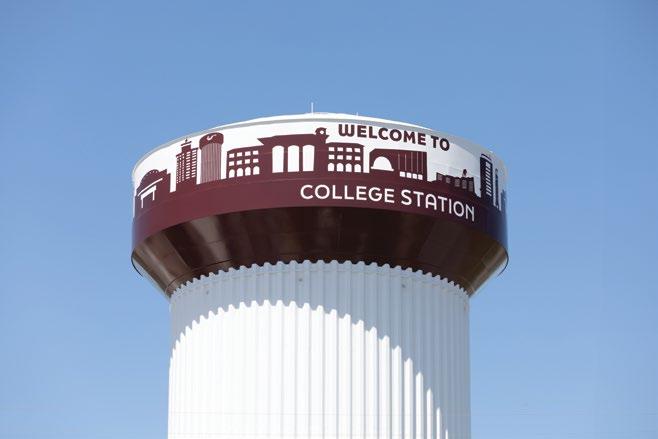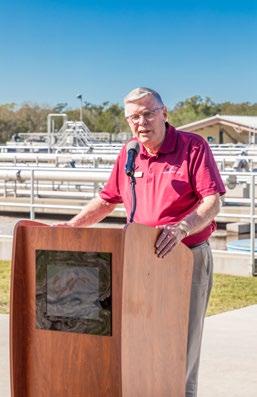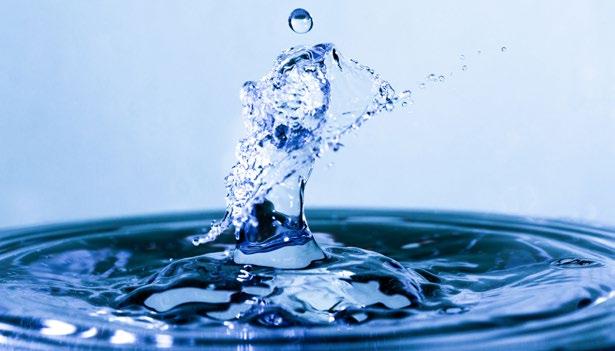Dear Customers,
I am pleased to provide you with this annual report about your drinking water quality. These reports are also known as Consumer Confidence Reports and are provided to customers as one of the requirements of the Safe Drinking Water Act.
Reading this report will help you become more knowledgeable about your water supply and the high-quality drinking water we provide. This report explains where your drinking water comes from, test results from monitoring conducted between Jan. 1, 2020-Dec. 31, 2023, and what we are doing to ensure our community continuously has clean, safe drinking water.
We are proud to report that, once again, our water has met all federal and state requirements, one of several factors that helped College Station maintain its Superior ranking from the Texas Commission on Environmental Quality. There is a lot of information in this report. If you have any questions or concerns about anything you read, please call 979.764.3660 or visit cstx.gov/water
John Nichols Mayor
INFORMACIÓN EN ESPAÑOL - Este reporte incluye información importante sobre el agua para tomar. Para asistencia en español, favor de llamar al telefono 979.764.3435.
WHAT ABOUT CONTAMINANTS?
Drinking water, including bottled water, may reasonably be expected to contain at least small amounts of some contaminants. The presence of contaminants does not necessarily indicate that water poses a health risk. More information about contaminants and potential health effects can be obtained by calling the Safe Drinking Water Hotline at 800.426.4791
Contaminants that may be present in source water include:
Microbial contaminants, such as viruses and bacteria, which may come from sewage treatment plants, septic systems, agricultural livestock operations, and wildlife.
Inorganic contaminants, such as salts and metals, which can be naturally-occurring or result from urban storm water runoff, industrial or domestic wastewater discharges, oil and gas production, mining, or farming.
Pesticides and herbicides, which may come from a variety of sources such as agriculture, urban storm water runoff, and residential uses.
Organic chemical contaminants, including synthetic and volatile organic chemicals, which are by-products of industrial processes and petroleum production, and can also come from gas stations, urban storm water runoff, and septic systems.
Radioactive contaminants, which can be naturally-occurring or be the result of oil and gas production and mining activities.
In order to ensure that tap water is safe to drink, EPA prescribes regulations which limit the amount of certain contaminants in water provided by public water systems. FDA regulations establish limits for contaminants in bottled water which must provide the same protection for public health.
Contaminants may be found in drinking water that may cause taste, color, or odor problems. These types of problems are not necessarily causes for health concerns. For more information on taste, odor, or color of your drinking water, call 979.764.3660.
DEFINITIONS & ABREVIATIONS
The following tables contain scientific terms and measures, some of which may require explanation.
ACTION LEVEL (AL): The concentration of a contaminant which, if exceeded, triggers treatment or other requirements which a water system must follow. Lead and Copper have Action Levels.
Level 1 Assessment: A Level 1 assessment is a study of the water system to identify potential problems and determine (if possible) why total coliform bacteria have been found in a water system.
Level 2 Assessment: A Level 2 assessment is a very detailed study of the water system to identify potential problems and determine (if possible) why an E. coli MCL violation has occurred and/or why total coliform bacteria have been found in a water system on multiple occasions.
MAXIMUM CONTAMINANT LEVEL (MCL): The highest level of a contaminant that is allowed in drinking water. MCLs are set as close to the MCLGs as feasible using the best available treatment technology.
MAXIMUM CONTAMINANT LEVEL GOAL (MCLG): The level of a contaminant in drinking water below which there is no known or expected risk to health. MCLGs allow for a margin of safety.
MAXIMUM RESIDUAL DISINFECTANT LEVEL (MRDL): The highest level of a disinfectant allowed in drinking water. There is convincing evidence that addition of a disinfectant is necessary for control of microbial contaminants.
MAXIMUM RESIDUAL DISINFECTANT LEVEL GOAL (MRDLG): The level of a drinking water disinfectant below which there is no known or expected risk to health. MRDLGs do not reflect the benefits of the use of disinfectants to control microbial contaminants.
ND: Not Detected
PPB: Micrograms per liter or parts per billion. Equivalent to one ounce in 7,350,000 gallons of water (think of it like 1 drop of water in an Olympic-size swimming pool).
PPM: Milligrams per liter or parts per million. Equivalent to one ounce in 7,350 gallons of water (think of it like 1 drop of water in a hot tub).
WATER QUALITY TEST RESULTS
Naturally present in the environment.
Erosion of natural deposits; Leaching from wood preservatives; Corrosion of household plumbing systems.
Corrosion of household plumbing systems; Erosion of natural deposits.
WHAT YOU NEED TO KNOW ABOUT LEAD IN DRINKING WATER
If present, elevated levels of lead can cause serious health problems, especially for pregnant women and young children. Lead in drinking water is primarily from materials and components associated with service lines and home plumbing. The City of College Station is responsible for providing high-quality drinking water but cannot control the variety of materials used in plumbing components. When your water has been sitting for several hours, you can minimize the potential for lead exposure by flushing the tap for 30 seconds to 2 minutes before using water for drinking or cooking. If you are concerned about lead in your water and would like to have it tested, call 979.764.3660. Information on lead in drinking water, testing methods, and steps you can take to minimize exposure is available from the Safe Drinking Water Hotline at or visit epa.gov/safewater/lead. DISINFECTANT RESIDUAL
DISINFECTION BY PRODUCTS
*The value in the Highest Level column is the highest average of all sample results collected at a location over a
INORGANIC CONTAMINANTS
Erosion of natural deposits; Runoff from orchards; Runoff from glass and electronics production wastes.
Discharge of drilling wastes; Discharge from metal refineries; Erosion of natural deposits.
Discharge from steel and pulp mills; Erosion of natural deposits.
Erosion of natural deposits; Water additive which promotes strong teeth; Discharge from fertilizer and aluminum factories.
Discharge from petroleum and metal refineries; Erosion of natural deposits; Discharge from mines.
SECONDARY CONSTITUENTS
Secondary contaminants do not relate to public health but rather to aesthetic effects such as taste, odor, and color.
UNREGULATED CONTAMINANT MONITORING
Under the Safe Drinking Water Act (SDWA), every five years the EPA issues a list of unregulated contaminants to be monitored by public water systems (PWSs). These contaminants come from the contaminant candidate list, which is a list of drinking water contaminants that are known or anticipated to occur in public water systems but not yet regulated by the EPA. Unregulated contaminant monitoring assists EPA in determining the occurrence of unregulated contaminants in drinking water and whether future regulation is warranted. Between 2023 and 2025, public water systems will sample for 30 different chemical contaminants including PFAS chemicals and Lithium. College Station’s monitoring was conducted in May and November 2023 and those results are listed below. For more information about the Unregulated Contaminant Monitoring Rule please visit epa.gov/dwucmr/learn-about-unregulated-contaminant-monitoring-rule.
A note about PFAS: PFAS is a shortened name for per- and polyfluoroalkyl substances, a group of chemicals that have been used since the 1940’s. PFAS are found in firefighting foam, waterproofing products, nonstick cooking equipment, stain-resistant carpets and furniture, plastic products, and more. Due to their widespread manufacture and use, exposure to PFAS comes from many avenues. But there is good news: the manufacture of many PFAS chemicals has been phased out, drinking water monitoring technology is now sophisticated enough to detect a wide array of contaminants at very low levels, and in April 2024 the Environmental Protection Agency established standards for six PFAS chemicals. The MCL for PFOA and PFOS is four parts per trillion, or PPT. For the other PFAS chemicals the MCL is ten parts per trillion. Parts per trillion is incredibly small: think one second in THIRTYTWO THOUSAND years. The table above shows detections of very small amounts of four of the PFAS chemicals, which were only detected in one of the two rounds of UCMR5 monitoring.

A NOTE ABOUT MEASURING WATER LOSS
The Texas Legislature requires all retail public water suppliers to file a water loss report annually and notify their customers of the water loss audit results. In the most recent water loss audit submitted to the Texas Water Development Board for the period of January – December 2023, the City of College Station water system recorded an estimated total water loss volume of 547,744,703 gallons. Water losses are attributed to water line breaks, leaks, inaccurate meter registration, and other causes. If you have any questions about the water loss audit, please contact Jennifer Nations at 979.764.6223. Help conserve limited water resources by reporting suspected water leaks to Utility Dispatch 24 hours per day at 855.528.4278
FOR MORE INFORMATION REGARDING THIS REPORT OR COLLEGE STATION WATER SERVICES, CONTACT: Jennifer Nations Water Resource Coordinator 979.764.6223 | jnations@cstx.gov
COLLEGE STATION UTILITIES ACCOUNT / BILLING QUESTIONS:
Utility Customer Service: 979.764.3535 cstx.gov/ucs
REPORT WATER, WASTEWATER & ELECTRIC ISSUES TO OUR 24/7 HOTLINE
855.528.4278
CITY






